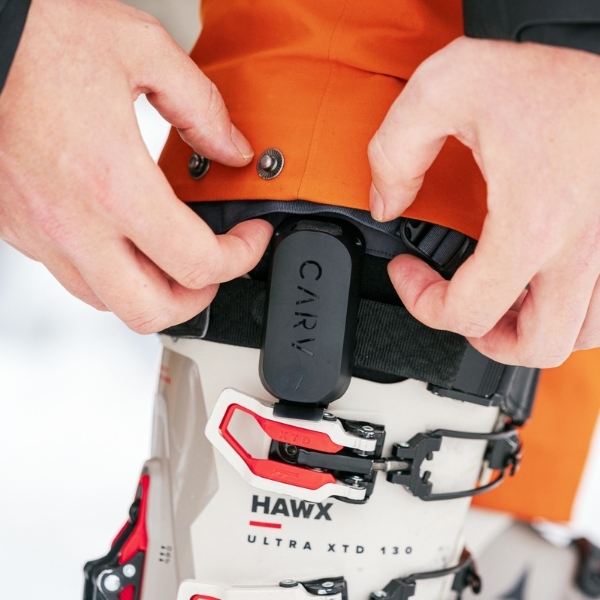
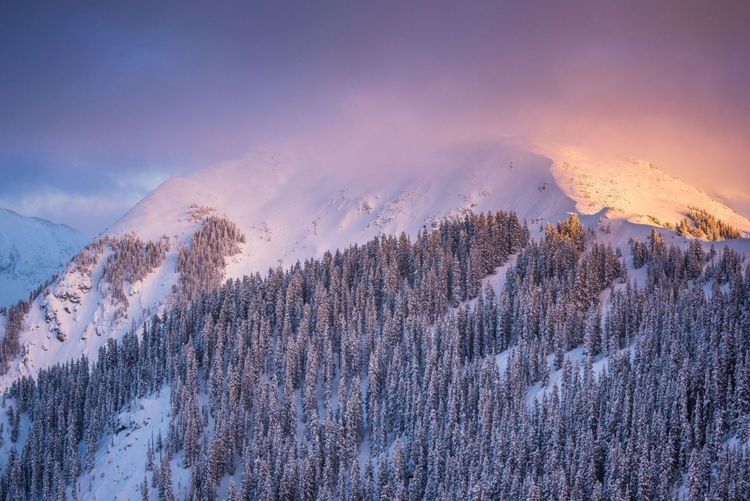
Taos Ski Valley Overview
Located in Northern New Mexico, in the Sangre de Cristo Mountains—the Southernmost range of the Rockies—Taos is a steep mountain with boom-or-bust snowfall. At just shy of 1,300 skiable acres, it’s quite a bit smaller than the biggest resorts in North America, but its aggressive vertical drop and excellent hikable terrain make it well worth the trip.
While it may be surprising to some people that New Mexico has skiing at all, Taos Ski Valley has been operating since 1955. With a base elevation of 9,350 feet, it’s the fifth-highest ski area in North America and tenth-highest in the world, receiving 300 inches of snow annually. It’s a 5 hour drive from Denver, or 3 hours from Albuquerque. The town of Taos, which is about 30 minutes from Taos Ski Valley, does have a small regional airport, however, flights there are on the pricey side.
Holders of the full Ikon Pass get 7 days at the resort, while those with Base Plus passes get 5. Base and Session passes do not grant access to Taos. While there are no blackout dates currently listed on the Ikon Pass site, holiday weekends have been blacked out in past seasons, so it’d be smart to double check before booking.
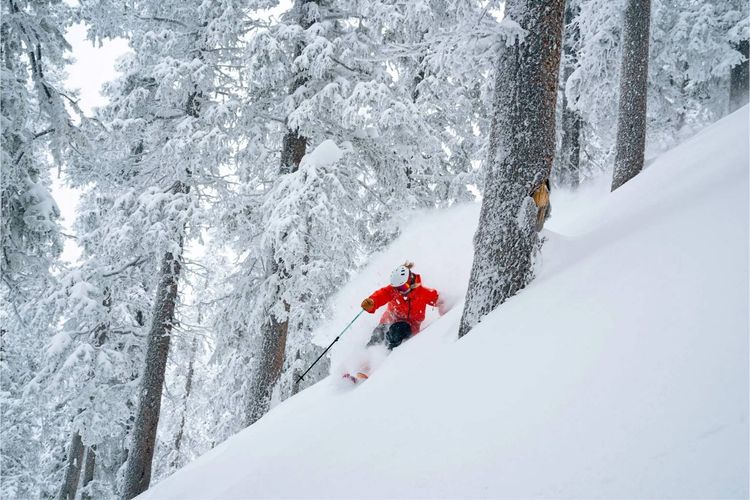
The Skiing in Taos Ski Valley
One of the first things you’ll see when you reach the base area and the bottom of Lift 1, other than incredibly steep, advanced terrain is a sign in red font telling you, “Don’t Panic! You’re looking at only 1/30 of Taos Ski Valley. We have many easy runs too!”
The sign is right—while the mountain looks really steep from the base area, or Resort Center, there are beginner (green) and intermediate (blue) runs on the front and back sides of the mountain. Nearly every chair serves beginner, intermediate, advanced (black), and expert (double black) runs, with the exception of the Kachina Peak Lift. Despite its intense verticality, Taos has plenty for everyone.
True beginners will likely want to get their feet under them by taking a snowsports lesson at Taos’ excellent ski school, located in the Rio Hondo Learning Center. There are a number of bunny hills to learn on here as well as in the Resort Center. Beginners who are ready to get onto the mountain, along with everyone else, will start by taking Lift 1—the only chair ascending from the base area.
From the top of Lift 1, you’ll have a few options; ride High Five or White Feather all the way back down to the Resort Center, or funnel down to Lift 2, which will take you to the top of the front side of the mountain. From there, you’ll have access to the back side of the mountain, which has many long, wide green runs.
Those who have graduated to blue runs will find fast groomers all over the mountain. After taking Lift 1 from the Resort Center, Porcupine and Powderhorn will both take you on an enjoyable ride back down the base area, but ski over to Lift 8 for the best intermediate runs—Lower Stauffenberg and Firefanz. The back side of the mountain boasts some of the most popular blue runs at Taos, which are a lot of fun on slower weekdays, but you’ll likely find yourself dodging other riders during peak times.
Advanced and expert skiers should be aware that due to Taos’ steepness, there is a slightly increased risk for in-bounds avalanches, especially on Kachina Peak. While Ski Patrol does conduct avalanche mitigation, the risk literally comes with the territory. Be aware and as always, observe signs and ropes.
Taos has a very well-deserved reputation for fantastic advanced and expert terrain. While a lot of the best expert runs on the mountain require hikes, there are advanced and expert runs serviced by nearly every chair as well. A great time can be had by lapping the lower front side steeps, serviced by Lift 1. Spencer’s, Rhoda’s, and Al’s Run are phenomenal, advanced bump and glade runs, while North American and Longhorn are awesome, steep, expert runs and are well worth your time.
When it’s open, Kachina Peak, on the back side of the mountain, can be reached by the Kachina Peak Lift. It offers some of the best expert skiing on the mountain, fantastic views, and epic powder stashes. If it’s open, go. If it isn’t, powder stashes can often be found on the back side in the terrain beneath Kachina Peak in Hunziker Bowl, High Noon, Staub, and El Funko.
For those willing to earn their turns, West Basin Ridge and Highline Ridge offer everything you could ask for in a big mountain environment—steep chutes, cliffs, trees, and glades. You can reach them by taking Lift 2, then clipping out of your skis before slipping through the gate on your right. There will be named runs available immediately on your right, or you can continue to hike up a bit until you reach the T intersection. On your left is Highline Ridge, which ends at the aforementioned Kachina Peak, while on the right is the West Basin Ridge. Generally speaking, the further you traverse on the ridges, the less spoiled the snow will be.
Regardless of when you choose to drop in, however, make sure to bring your A-game. The ridges are legendary for a reason, and feature some of the most difficult in-bounds skiing you’ll find anywhere. If you start having second thoughts while traversing West Basin Ridge, keep going all the way to the end of the line to Wild West Glade for a long, less steep, but still challenging glade run down the resort’s shoulder.
While there’s no backcountry access at Taos, there is great backcountry skiing in the area. Just make sure to avoid Taos Pueblo and other private land.
Taos has one terrain park that’s lappable via Lift 7. It’s pretty small and contains small and medium features.


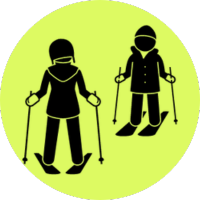

Eating Out in Taos Ski Valley
No trip to New Mexico would be complete without sampling the excellent southwestern food, and visitors to Taos won’t be short on opportunities to do so. The cornerstone of New Mexican cuisine is the chile pepper, which comes in two varieties—red and green. You’ll see chiles everywhere—even hanging from Lift 1, in the Resort Center. Grab a breakfast burrito, bowl of green chili, or serving of enchiladas while you’re here. You won’t regret it.
The base area, or Resort Center, has pretty standard food options that will be familiar to regular skiers. Pizza, burgers, and other basics are available at dining halls and in restaurants with table service, alongside southwestern options.
Cid’s Mountain Market is a local upscale grocer with an outpost at the resort that sells great grab-and-go breakfast burritos, burgers, and other hot and cold options. It’s probably your best bet for a quick bite.
The back side of the mountain is home to The Bavarian Restaurant, which serves Bavarian specialties like schnitzels, sausages, pretzels, and goulash, as well as a number of German beers on draught and canned domestics. They have a huge outdoor deck, but sit inside for the full Alpine experience—the place is as warm and authentic as a bowl of green chili (which you won’t find on the menu). The Bavarian Restaurant is accessible by ski and by car, and serves lunch and dinner.
Those staying in town will have a wider variety of restaurant options.
Doc Martin’s, located in the historic Taos Inn, serves fantastic traditional southwestern food in a lovely environment. Ask to sit in the hotel lobby area if they’re hosting live music, which they do every night. Lambert’s of Taos and the Love Apple are both great choices for upscale contemporary American food. La Cueva Cafe is a perfect no-frills, wallet-friendly option for tasty southwestern food.
For breakfast, stop into Michael’s Kitchen and Restaurant for a green and/or red chili-smothered breakfast burrito, breakfast enchilada, or a more traditional breakfast dish. Just leave room for a giant homemade cinnamon roll with cream cheese frosting. Getting a table can take a while, so don’t come here expecting a quick bite if you’re hoping to get to the mountain early.
The Après-Ski in Taos Ski Valley
The après scene in Taos is not big or glitzy by any means. You won’t find European or Aspen-style après bars, but there is a good time to be had at one of its charming, authentic local cantinas.
If you’re staying at the resort, you’ll want to après there too, unless you have a designated driver. There’s essentially nothing between the resort and town, and there are no Ubers or Lyfts to bring you the 30 minutes back from town to the resort. Stick with The Bavarian, 192 at the Blake, Rhoda’s, or Taos Ale House. While they aren’t open very late, a casual good time can be had.
There are a number of bars in town, but the only real energetic late-night spot is The Alley Cantina. Occupying the oldest building in town, just down an alley from the plaza, The Alley Cantina is the spot for a night of cheap drinks, live music, dancing, and a game of pool or shuffleboard. You’ll probably see the same people here every night of your trip, which can be pretty fun.
In addition to the Alley Cantina, the Adobe Bar at the Taos Inn is a great spot for killer margaritas and live music. It serves as a gathering space for the entire town, and offers a great opportunity to mingle with the friendly and eccentric locals.
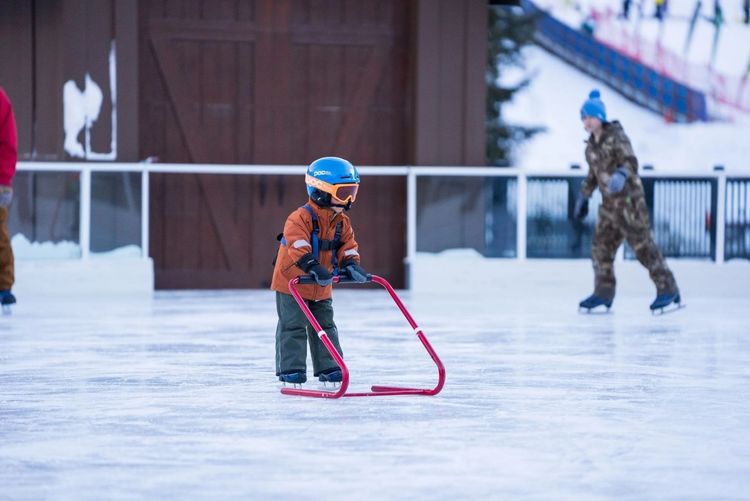
Taos Ski Valley for Families
Taos has an excellent ski school, but families with non-skiing kids might find themselves short on alternate activities if they’re staying at the resort. It’s not much of a party mountain, and lines are generally short, both of which are pluses for families of skiers.
Activities for Non-Skiers
Non-skiers who are still interested in participating in the winter fun have many options in Taos. The Resort Center has an ice rink that rents skates, and hosts various fun events like ice bocce and a silent disco. Additionally, the resort has a sledding hill that’s great for all ages. It’s completely free but you’ll need to bring or rent your own sled.
Those looking for a more adventurous non-skiing option should consider snowshoeing or snowmobiling. Guided tours and rentals are available in Taos Ski Valley or through various companies in town.
In addition to winter sports, Taos is famous for its art and history. The resort borders the Taos Pueblo, a UNESCO World Heritage Site which is home to an ancient pueblo that is one of the oldest continually-inhabited structures in the United States, built around 1,000 A.D. The Pueblo welcomes visitors for tours and various events throughout the year.
In 1915, a group of artists charmed by the town’s natural beauty and history started the Taos Society of Artists, and the town’s reputation as a haven for artists has only grown in years since. Today, there are many galleries, museums, and festivals for visitors to experience the art that’s being created here, or you can explore your own creativity by taking a workshop led by a local artist, chef, or writer.
The house where Kit Carson, the famous frontiersman, raised his family is only a block from the Taos Plaza. It currently houses the Kit Carson Museum, which is open Thursday to Sunday.
Accommodation in Taos Ski Valley
Taos Ski Valley is a 30 minute drive from the town of Taos. Most of the lodging options are either in Taos Ski Valley or Taos itself, but there are a few neighbourhoods and another small town called Arroyo Seco between the two that have rental properties and a few small hotels. Generally speaking, accommodations are very affordable.
In Taos Ski Valley, there are numerous ski-in/ski-out condos and hotels, most of which are pretty standard for what you’d find at any major resort. The Blake is the nicest of the options.
In town, there are lots of rental properties and hotels to choose from. If you’re searching for character and charm, check out the Taos Inn. The historic adobe-style hotel is within walking distance of nearly everything in town, has a fantastic bar and restaurant, and many rooms have their own wood-burning kiva fireplaces.
Environment and Sustainability in Taos Ski Valley
Taos is truly an industry leader in sustainability and environmental action, and has received numerous recognitions from the National Ski Areas Association and other organizations for their accomplishments.
In 2017, Taos became the first ski resort in the world to achieve status as a certified B-Corporation by meeting high standards for social and environmental performance, public transparency, and balance of profit and purpose. It remains the only ski resort with B-Corp status.
Additionally, Taos is a carbon neutral resort, and is on track to achieve net zero emissions by 2030.
Pros & Cons of Taos Ski Valley
Pros
- World-class advanced and expert terrain
- Award-winning ski school
- Thin crowds due to remote location
- Relatively affordable accommodations
- Still holds onto much of its small resort charm
- In a region rich in unique history and culture
- Industry-leader in sustainability
Cons
- Snow can be unpredictable, and the steep grades don’t ski well when low on snow
- Beginner and intermediate runs are steeper than at other resorts
- Limited lift infrastructure—have to hike to many great runs
- Small après scene
- Far from major cities
- Higher than average inbounds avalanche risk
- Small base area with somewhat limited dining and accommodation options
Recent Reviews
Taos Ski Valley Resort Stats
Taos Ski Valley Travel Information
FAQs Skiers' Most Asked Questions
Taos Ski Valley FAQs: Skiers' Most Asked Questions
Is Taos Ski Valley snow-sure?
While Taos Ski Valley benefits from high elevation (3,804m at the peak) that helps preserve snow quality, it isn't considered completely snow-sure. Our users note the resort sometimes lacks the heavy snowfall that other Rocky Mountain resorts receive. However, as one expert skier points out, "with the high elevation and many north aspects, soft snow and sometimes even powder can be found days after a storm." When it does snow, users rave about the quality.
What mountain range is Taos Ski Valley part of?
Taos Ski Valley is nestled in the Sangre de Cristo Mountains, the southernmost subrange of the Rocky Mountains. This spectacular range extends from southern Colorado into northern New Mexico, providing the perfect alpine terrain that makes Taos so revered among skiers. Our users rate it 4.50/5 overall, with one Snomad community member describing it as having "some of the steepest trees I've ever skied."
When does the ski season start and end in Taos Ski Valley?
Taos Ski Valley typically opens in late November (around U.S. Thanksgiving) and runs through early April, depending on snow conditions. One Snomad community member notes that despite not always getting the same snowfall as other Rocky Mountain resorts, the high elevation and north-facing aspects help preserve conditions. The resort's 5.00/5 rating for intermediates and 4.63/5 for experts means there's plenty to enjoy throughout the season.
Is Taos Ski Valley good for beginners?
Taos isn't ideal for complete beginners. While there are enough green runs to keep novices busy, the mountain wasn't designed with them in mind. One Snomad community member who's a beginner noted that "the small hill was perfect" but admitted "not a lot for beginners." With a rating of 4.00/5 for beginners, Taos is better suited to those looking to progress rather than first-timers. The ski school, however, gets excellent reviews.
Is Taos Ski Valley good for intermediate skiers?
Absolutely! Taos Ski Valley is fantastic for intermediate skiers, scoring a perfect 5.00/5 for intermediates. While the resort is known for challenging terrain, it offers excellent groomed runs for progression. One Snomad community member liked that "there are some great long groomed runs" alongside the steeper stuff. The variety of trails allows intermediates to comfortably push their skills while enjoying the unique southwestern charm that makes Taos special.
Is Taos Ski Valley good for advanced skiers?
Taos Ski Valley is exceptional for advanced skiers, scoring 4.33/5 for advanced skiing and 4.63/5 for experts. Our users rave about the steep terrain, challenging chutes, and technical tree runs. One Snomad community member liked that "Taos has some of the steepest trees I've ever skied along with big open bowl skiing from the Kachina lift." The West Basin Ridge offers particularly extreme terrain, and the long, demanding mogul runs will test even the most skilled skiers.
Is Taos Ski Valley good for expert skiers?
Absolutely! Taos Ski Valley is a paradise for expert skiers, scoring 4.63/5 for experts. One Snomad community member described it as having "some of the steepest trees I've ever skied along with big open bowl skiing." The West Basin Ridge offers the most extreme terrain, with what users call "insane chutes" and "crazy steeps everywhere." Multiple reviewers mention the challenging mogul runs and exceptional tree skiing. It should definitely be on your "must-ski" list!
Is Taos Ski Valley good for non-skiers?
Taos Ski Valley offers limited non-skiing activities compared to larger resorts. While the area has beautiful scenery and a unique Southwestern cultural vibe, most amenities focus on skiing. The nearby town of Taos (20 minutes away) provides more options with its art galleries, museums, and dining. Some users mention the welcoming atmosphere and good food options, with the resort earning 4.00/5 for eating out, but the main attraction remains the mountain experience.
Is there snow at Christmas in Taos Ski Valley?
Taos Ski Valley typically has good snow conditions at Christmas. With a high base elevation of 2,804m and a top elevation of 3,804m, the resort maintains reliable snow coverage during the festive period. Our users consistently mention the quality of skiing during holiday times. The resort's overall rating of 4.50/5 and strong scores for powder zones (4.38/5}) reflect its reputation for excellent snow conditions throughout the winter season.
Where should I stay in Taos Ski Valley and what type of accommodation is available?
Taos Ski Valley offers a range of accommodation options with our users rating them 4.20/5 overall. You can stay in the main Village area at the base of the mountain for ski-in/ski-out convenience, or choose the quieter Amizette area just a few minutes down the canyon.
Some Snomad community members prefer the authentic vibes of Arroyo Seco (15 minutes away) or Taos town (30 minutes away). As Daniel, an advanced skier, noted: "The resort had a local vibe to it that was incredibly welcoming and cool." Accommodation types range from luxury condos and hotels in the Village to more affordable options in town.
What's the best way to get to Taos Ski Valley?
For international travellers, the most convenient route to Taos Ski Valley is flying into Albuquerque International Sunport (ABQ), about 135 miles south of the resort. From there, rent a car for a scenic 2.5-hour drive, or book the Taos Ski Valley shuttle service. Alternatively, Santa Fe Regional Airport is closer (90 minutes away) but offers fewer international connections. One Snomad community member noted that despite the journey, "the local vibe is incredibly welcoming and cool" once you arrive.







